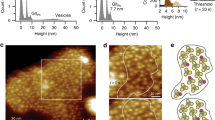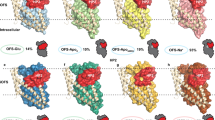Abstract
Excitatory amino acid transporters (EAATs) are secondary transport proteins that mediate the uptake of glutamate and other amino acids1. EAATs fulfil an important role in neuronal signal transmission by clearing the excitatory neurotransmitters from the synaptic cleft after depolarization of the postsynaptic neuron. An intensively studied model system for understanding the transport mechanism of EAATs is the archaeal aspartate transporter GltPh2,3,4,5,6. Each subunit in the homotrimeric GltPh supports the coupled translocation of one aspartate molecule and three Na+ ions2 as well as an uncoupled flux of Cl− ions7. Recent crystal structures of GltPh3,5,6,8 revealed three possible conformations for the subunits, but it is unclear whether the motions of individual subunits are coordinated to support transport. Here, we report the direct observation of conformational dynamics in individual GltPh trimers embedded in the membrane by applying single-molecule fluorescence resonance energy transfer (FRET). By analysing the transporters in a lipid bilayer instead of commonly used detergent micelles, we achieve conditions that approximate the physiologically relevant ones. From the kinetics of FRET level transitions we conclude that the three GltPh subunits undergo conformational changes stochastically and independently of each other.
This is a preview of subscription content, access via your institution
Access options
Subscribe to this journal
Receive 51 print issues and online access
$199.00 per year
only $3.90 per issue
Buy this article
- Purchase on Springer Link
- Instant access to full article PDF
Prices may be subject to local taxes which are calculated during checkout




Similar content being viewed by others
References
Kanner, B. I. & Zomot, E. Sodium-coupled neurotransmitter transporters. Chem. Rev. 108, 1654–1668 (2008)
Groeneveld, M. & Slotboom, D. J. Na+:aspartate coupling stoichiometry in the glutamate transporter homologue GltPh . Biochemistry 49, 3511–3513 (2010)
Reyes, N., Ginter, C. & Boudker, O. Transport mechanism of a bacterial homologue of glutamate transporters. Nature 462, 880–885 (2009)
Ryan, R. M., Compton, E. L. & Mindell, J. A. Functional characterization of a Na+-dependent aspartate transporter from Pyrococcus horikoshii. J. Biol. Chem. 284, 17540–17548 (2009)
Yernool, D. et al. Structure of a glutamate transporter homologue from Pyrococcus horikoshii. Nature 431, 811–818 (2004)
Boudker, O. et al. Coupling substrate and ion binding to extracellular gate of a sodium-dependent aspartate transporter. Nature 445, 387–393 (2007)
Ryan, R. M. & Mindell, J. A. The uncoupled chloride conductance of a bacterial glutamate transporter homolog. Nature Struct. Mol. Biol. 14, 365–371 (2007)
Verdon, G. & Boudker, O. Crystal structure of an asymmetric trimer of a bacterial glutamate transporter homolog. Nature Struct. Mol. Biol. 19, 355–357 (2012)
Georgieva, E. R. et al. Conformational ensemble of the sodium-coupled aspartate transporter. Nature Struct. Mol. Biol. 20, 215–221 (2013)
Hänelt, I. et al. Conformational heterogeneity of the aspartate transporter GltPh . Nature Struct. Mol. Biol. 20, 210–214 (2013)
Joo, C. et al. Advances in single-molecule fluorescence methods for molecular biology. Annu. Rev. Biochem. 77, 51–76 (2008)
Verhalen, B. et al. Dynamic ligand-induced conformational rearrangements in P-glycoprotein as probed by fluorescence resonance energy transfer spectroscopy. J. Biol. Chem. 287, 1112–1127 (2012)
Zhao, Y. et al. Substrate-modulated gating dynamics in a Na+-coupled neurotransmitter transporter homologue. Nature 474, 109–113 (2011)
Zhao, Y. et al. Single-molecule dynamics of gating in a neurotransmitter transporter homologue. Nature 465, 188–193 (2010)
Akyuz, N. et al. Transport dynamics in a glutamate transporter homologue. Nature http://dx.doi.org/10.1038/nature12265 (23 June 2013)
Dorwart, M. R. et al. S. aureus MscL is a pentamer in vivo but of variable stoichiometries in vitro: implications for detergent-solubilized membrane proteins. PLoS Biol. 8, e1000555 (2010)
Floyd, D. L., Harrison, S. C. & van Oijen, A. M. Analysis of kinetic intermediates in single-particle dwell-time distributions. Biophys. J. 99, 360–366 (2010)
Koch, H. P. & Larsson, H. P. Small-scale molecular motions accomplish glutamate uptake in human glutamate transporters. J. Neurosci. 25, 1730–1736 (2005)
Grewer, C. et al. Individual subunits of the glutamate transporter EAAC1 homotrimer function independently of each other. Biochemistry 44, 11913–11923 (2005)
Koch, H. P., Brown, R. L. & Larsson, H. P. The glutamate-activated anion conductance in excitatory amino acid transporters is gated independently by the individual subunits. J. Neurosci. 27, 2943–2947 (2007)
Blanchard, S. C. et al. tRNA dynamics on the ribosome during translation. Proc. Natl Acad. Sci. USA 101, 12893–12898 (2004)
van der Heide, T. & Poolman, B. Osmoregulated ABC-transport system of Lactococcus lactis senses water stress via changes in the physical state of the membrane. Proc. Natl Acad. Sci. USA 97, 7102–7106 (2000)
Tanner, N. A. & van Oijen, A. M. Visualizing DNA replication at the single-molecule level. Methods Enzymol. 475, 259–278 (2010)
Cordes, T., Vogelsang, J. & Tinnefeld, P. On the mechanism of Trolox as antiblinking and antibleaching reagent. J. Am. Chem. Soc. 131, 5018–5019 (2009)
Kapanidis, A. N. et al. Alternating-laser excitation of single molecules. Acc. Chem. Res. 38, 523–533 (2005)
Guizar-Sicairos, M., Thurman, S. T. & Fienup, J. R. Efficient subpixel image registration algorithms. Opt. Lett. 33, 156–158 (2008)
Reddy, B. S. & Chatterji, B. N. An FFT-based technique for translation, rotation, and scale-invariant image registration. IEEE Trans. Image Process. 5, 1266–1271 (1996)
Hedde, P. N. et al. Online image analysis software for photoactivation localization microscopy. Nature Methods 6, 689–690 (2009)
Acknowledgements
The authors would like to thank M. Punter for developing software and algorithms for data analysis, V. Krasnikov for his help with the design, construction and maintenance of the single-molecule fluorescence microscopes and I. Küsters for sharing experience on liposome tethering and single-molecule imaging of membrane proteins. A.M.v.O. acknowledges funding from the Netherlands Organization for Scientific Research (NWO; Vici 680-47-607) and the European Research Council (ERC Starting 281098). D.J.S. acknowledges funding from the Netherlands Organization for Scientific Research (NWO; Vidi 700.54.423, Vici 865.11.001) and the European Research Council (ERC Starting 282083). I.H. acknowledges the Deutsche Forschungsgemeinschaft (HA 6322/1-1) for providing funding.
Author information
Authors and Affiliations
Contributions
G.B.E., I.H., J.M.H.G., D.J.S. and A.M.v.O. designed experiments, G.B.E. and I.H. performed experiments, J.M.H.G. performed the FRET level transition calculations, G.B.E., D.J.S. and A.M.v.O. wrote the manuscript, all authors contributed to the interpretation of the data.
Corresponding authors
Ethics declarations
Competing interests
The authors declare no competing financial interests.
Supplementary information
Supplementary Information
This file contains Supplementary Text and Data, which include Supplementary Methods, Supplementary Table, 1, Supplementary Figures 1-3 and a Supplementary Reference. (PDF 680 kb)
Rights and permissions
About this article
Cite this article
Erkens, G., Hänelt, I., Goudsmits, J. et al. Unsynchronised subunit motion in single trimeric sodium-coupled aspartate transporters. Nature 502, 119–123 (2013). https://doi.org/10.1038/nature12538
Received:
Accepted:
Published:
Issue Date:
DOI: https://doi.org/10.1038/nature12538
This article is cited by
-
Multi-parameter photon-by-photon hidden Markov modeling
Nature Communications (2022)
-
Regulation of the mammalian-brain V-ATPase through ultraslow mode-switching
Nature (2022)
-
Molecular Basis of Coupled Transport and Anion Conduction in Excitatory Amino Acid Transporters
Neurochemical Research (2022)
-
Kinetic mechanism of Na+-coupled aspartate transport catalyzed by GltTk
Communications Biology (2021)
-
Glutamate transporters have a chloride channel with two hydrophobic gates
Nature (2021)
Comments
By submitting a comment you agree to abide by our Terms and Community Guidelines. If you find something abusive or that does not comply with our terms or guidelines please flag it as inappropriate.



